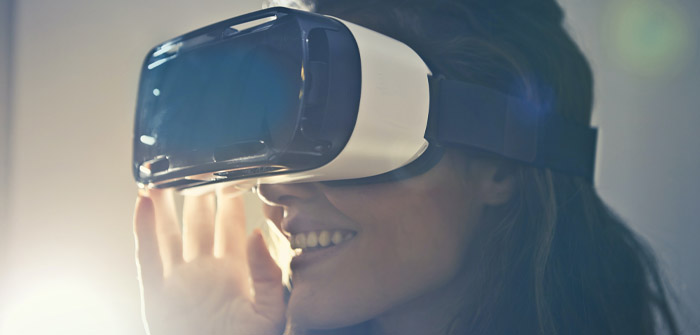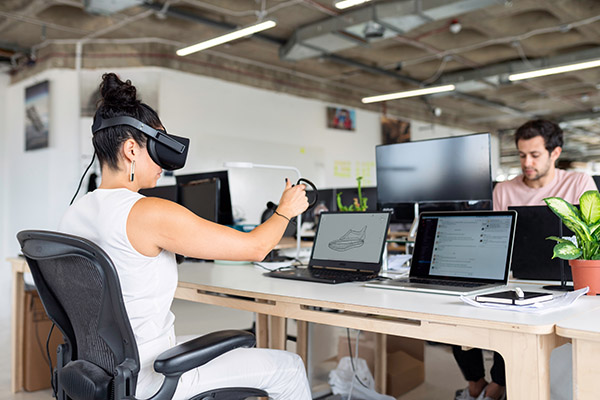Virtual Reality enables businesses to demonstrate their products either online or through a VR headset. The two main types of VR content are 360-degree videos and 3D animations.
Marketing products using virtual reality allows companies to bridge the gap between experience and action. You can use VR to offer a digital experience in place of a physical one, which can immerse users in the virtual world whilst showcasing your product.
Now, more than ever, marketing is being driven by the desires of the customer. As new technology becomes available, customers will demand that it be utilized. This means it is important that marketers keep pace with new advances in order to meet customer expectations and deliver the best possible experiences. Virtual Reality has already been adopted by several sectors, so failing to utilize it could leave you lagging behind your competition.
Uses of Virtual Reality
Travel Industry
Travel companies are using VR to showcase hotels to prospective visitors and enable them to experience tours of the local area. A VR video gives users the opportunity to embark on an immersive journey through the hotel’s rooms, explore its facilities, take a walk around the resort, see the location and even make a direct booking. A study for the Omni Hotels chain showed that people who experienced a VR tour were 67% more likely to book a room in the hotel. The same study also demonstrated a 16% increase in the overall number of bookings when virtual reality was used.
House Building
House builders were early adopters of 360-degree tours to guide visitors around show homes and showcase developments. VR is a great way to view houses that are not yet built. Real estate agents are now also offering virtual tours of houses they are selling. Allowing visitors to view a house virtually before they visit physically encourages better qualified leads as visitors can reject houses that are not for them before arranging a viewing, saving everyone time.
Retail
In its attempts to not lose business to e-commerce, the retail sector is quick to adopt new technologies to market their products and services. Retailers of home decor, furniture, cars, and clothes have been experimenting with the VR technology for some time offering virtual placements, VR test drives, and VR try-ons. IKEA offers the ability to virtually ‘place’ furniture in your room to see how it will fit. You can also virtually install their kitchens to experience how they will look.
Volvo allowed members of the public to virtually test drive their new XC90 SUV. The software puts you in the cockpit of the car and takes you on a scenic ride through the countryside. This is a good move by Volvo – a company that has struggled perhaps to appear modern and relevant compared to their competitors. By adopting VR in this way they’ve made the public look at their brand in a new light.
Samsung, in conjunction with NASA, has created an immersive 4D VR experience which allows users to virtually walk on the moon. Users step into a flight suit and harness whilst wearing a Gear VR headset. They are then immersed in a visual and physical experience that recreates a real moon mission.
Beauty
Beauty giant L’Oréal has created an app that allows customers to use their smartphone cameras to snap pictures of themselves and apply virtual L’Oréal products – such as lipsticks and nail polishes – onto the image. It also allows customers to turn their head to view the appearance of the products from different angles. Many customers have a problem with visualizing how products will appear on their own skin or nails, and it may not always be desirable to use samples. The app technology gives users a way to test L’Oréal products virtually, ahead of making a purchase decision.
Exhibition Industry
With all live events cancelled last year due to the pandemic, the exhibition industry has had to rapidly embrace VR technology. Live events have been replaced by virtual events with visitors able to tour exhibition halls and stop at virtual stands, interacting with businesses via messaging. However with the end of lock-down, live events are certain to make a comeback, Alan Jenkins of exhibition stand designer Quadrant2Design said “While virtual events have their uses, they don’t replace the benefits reaped by attending a live trade show, you can’t network and really the best way to market a company online is through a website, not a virtual trade show stand”.
Benefits of VR Marketing
- VR offers an enhanced user experience – VR can allow users to experience a place virtually which might encourage them to then experience it physically. Customers can ‘try before they buy’.
- Stay one step ahead of your competitors – 3D modelling and 360-degree tours are being adopted more and more widely, utilizing them will demonstrate that you are an advanced, technology-oriented company.
- It generates higher user engagement and brand recognition – Studies show that, in general, consumers are more inclined to buy from a brand that uses VR than from others. Consumers have an emotional reaction to VR content and become more open to the brand.
- You can use a unique VR offering to generate media coverage which may in turn lead to increased sales.
How to develop a VR marketing strategy
360-degree videos
This is definitely the cheaper option for VR content, though it does not mean it is poor or inferior. A 360-degree video is a perfect way to create immersive experiences from any event or location in the world. It requires specialist equipment, though. To begin with, you need a spherical camera with 360-degree lens and tripods (plus Steadicams). Using a drone is also a viable option. For post-production, you will need special editing software, such as Videostitch, to bring all the footage together in one piece and ensure high quality visuals.
Web Design companies like Quadrant2Design offer to make 360-degree tours as an add-on to their web design services. This will be cheaper and easier than buying all the equipment yourself.
3D Animations
There are plenty of tools and platforms to create simple virtual 3D environments, such as Maya, Structure Sensor, 3dsMax, LightWave, Modo, Cinema 4D, Houdini, etc. If you want to produce something bigger and more complex, like 3D VR games, you can use game engines like Unity or Unreal, and you would also need Google VR SDK, a VR headset and an Android phone. With the Unity engine, you can also build 3D models, animations, interior designs.
The Future
Virtual reality, creating experiences unlike any other software, gives the user a unique experience of a product, leaving long-term memories. Brands integrating VR in their marketing campaigns will benefit from this effect which will immediately make them stand out from their competitors.
We cannot say that virtual reality in marketing is still in its infancy, as there are already lots of examples of successful use of VR in websites and promotional campaigns. We may be safe to say that it is in its childhood period with the wide adoption and new formats just around the corner. Soon, we may see VR replacing the traditional forms of advertising with consumers able to try new products or services in a virtual space before experiencing them physically.






